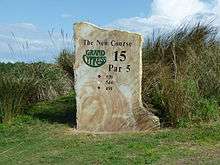Par (golf scoring format)

- This article is about the scoring system "Par", that is commonly used in Australian club golf as an alternative to Stableford and normal stroke play. The Par (score) page provides a general definition of par on a golf hole.
Par is a scoring system used mostly in amateur and club golf. It involves scoring (+, 0, −) based on results at each hole. The objective is to have an end score with more pluses than minuses. The result on each hole is always based on one's handicap-adjusted score.
For ease of explanation, assume a player's handicap gives him/her one stroke per hole (i.e., 9-hole handicap of 9). This player, playing to his/her handicap on a given day, will average a bogey on each hole. Playing 'to' ones handicap is expected and so there is no reward or punishment due when a bogey 5 is recorded on a par 4. Thus, a 0 (zero) is recorded. A double-bogey 6 (one over what's expected from a player on a 9 handicap, would incur a penalty of a minus '−'. A 4 (a genuine, unadjusted par) is one better than a '9-handicapper' would be expected to score and would earn a plus '+'. However, for this golfer, 6s and above still incur just one minus '−'. Likewise, 4s and below earn just one plus '+'. At the end of the round, plusses and minuses are reconciled (a minus cancels out a plus). If a player finishes with two plusses, s/he is 'two up' or 'plus 2' (+2). The opposite applies if s/he finishes with two minuses - 'two down'; 'minus 2'; '−2'.
The Par format's main disadvantage is that there is no reward for a handicap-adjusted eagle (or even better).